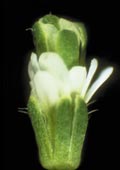| |
Accelerating the Pace
The U.S. component of the multinational effort to sequence the Arabidopsis genome started as a joint program by NSF, the U.S. Department of Agriculture (USDA), and the Department of Energy (DOE). Building on this effort, in May 1997 the White House Office of Science and Technology Policy (OSTP) established the National Plant Genome Initiative (NPGI) program with the long-term objective to understand the genetic structure and functions in plants important to agriculture, the environment, energy, and health. In the NPGI's first year, NSF, USDA, and DOE provided additional funds to accelerate completion of Arabidopsis sequencing. The international Arabidopsis community now expects to publish the complete sequence of the plant's genome by the end of 2000, four years ahead of the original schedule.
In 1999 U.S. and European scientists completed mapping the DNA sequences of two of the five chromosomes of Arabidopsis and published their findings in the December 16,.1999 issue of Nature.  The results—the first complete DNA sequence of a plant chromosome—provided new information about chromosome structure, evolution, intracellular signaling, and disease resistance in plants. The results—the first complete DNA sequence of a plant chromosome—provided new information about chromosome structure, evolution, intracellular signaling, and disease resistance in plants.
Through the NPGI program, NSF, USDA, and DOE also began jointly funding research to sequence the rice genome, enabling U.S. participation in an international collaboration whose goals are set by the International Rice Genome Sequencing Working Group. Most of the world's major food crops (including rice) are grasses, and they share common sets of genes. The relatively small size of the rice genome—430 million base pairs of DNA divided into 12 chromosomes—makes it a model system for understanding the genomic sequences of other major grass crops including corn, wheat, rye, barley, sorghum, sugar cane, and millet. The working group estimates that researchers could complete the sequencing of the rice genome by 2008.
With rice and other plant sequencing efforts underway and with the completion of the Arabidopsis genome sequence tantalizingly close, plant researchers have begun to shift their focus from gene identification to functional genomics—a multidisciplinary approach to develop an understanding of the functions of the plant's genes and how they work together under different conditions. A systematic effort to effectively use the massive amounts of genome data becoming available to determine the functions of all of the genes of Arabidopsis is seen as the next frontier in plant research. Such an effort could be accomplished by 201 0, according to a recent estimate, and would lead to an integrated database that would be a blueprint of Arabidopsis through its entire life cycle.
Research to understand the functions of Arabidopsis's gene sequences are still in the early stages but breakthroughs with considerable practical applications could come in the areas of:
 DISEASE RESISTANCE. Plant breeders have long known that certain varieties of crops are more resistant than others to particular viral, bacterial, or fungal pathogens. Disease resistance is a major goal of most plant-breeding programs, but it has typically been a long process involving crop plants found in natural wild populations. The process has been impeded by the "species barrier," which, until recently, prevented desirable genes from being passed around—from corn to cauliflower, for example. Arabidopsis researchers have determined the molecular sequences of genes that code for disease resistance and, in addition, the processes by which Arabidopsis and perhaps other plants marshal their defenses against pathogens. This discovery may be particularly useful in triggering resistance to disease in species other than Arabidopsis. In one enticing example, a bacterial pathogen of mammals was also discovered to be an Arabidopsis pathogen. Some of the same factors are required for infection, leading researchers to speculate that evolutionary susceptibility to disease may be accompanied by factors that confer resistance. DISEASE RESISTANCE. Plant breeders have long known that certain varieties of crops are more resistant than others to particular viral, bacterial, or fungal pathogens. Disease resistance is a major goal of most plant-breeding programs, but it has typically been a long process involving crop plants found in natural wild populations. The process has been impeded by the "species barrier," which, until recently, prevented desirable genes from being passed around—from corn to cauliflower, for example. Arabidopsis researchers have determined the molecular sequences of genes that code for disease resistance and, in addition, the processes by which Arabidopsis and perhaps other plants marshal their defenses against pathogens. This discovery may be particularly useful in triggering resistance to disease in species other than Arabidopsis. In one enticing example, a bacterial pathogen of mammals was also discovered to be an Arabidopsis pathogen. Some of the same factors are required for infection, leading researchers to speculate that evolutionary susceptibility to disease may be accompanied by factors that confer resistance.
CIRCADIAN RHYTHMS. A vast array of processes in plants are regulated in a circadian manner, including daily leaf movements and pore openings, flower-blooming schedules, and photosynthesis cycles. The term "circadian" comes from the Latin words circa, meaning about, and diem, meaning day. It refers to processes that occur approximately once every twenty-four hours, in response to an organism's internal clock. Plants gain a strong adaptive advantage by being able to anticipate oncoming dawn or dusk, rather than merely responding to the presence or absence of light. They display this ability even as days grow shorter in the fall or longer in the spring. By fusing Arabidopsis genetic material with bioluminescent material from fireflies, researchers have been able to observe a glowing pattern of response that reflects the plants' internal clocks. This enabled them to find mutants with aberrant responses, which in turn led to identification of a biological clock gene named "toc." Although influenced by sunlight, "toc" also operates independently, even when the plant is in constant darkness.
ENVIRONMENTAL RESPONSE. Plants respond to a great deal of information from the type of daylight they receive. For example, the changing light throughout the year provides clues about whether it is time to sprout or time to make seeds. When an object blocks the light, plants respond by growing around the object to reach the light. Much of our current information about how plants perceive and respond to light is derived from studies with Arabidopsis. These studies have identified the basic genetic framework of light perception and the complex communications system, called a signal transduction network, through which plants act upon information from their photoreceptors. There has also been signiflcant progress in understanding how plants respond genetically when exposed to stresses in the environment, such as ozone, UV-irradiation, touch, cold, and oxygen deprivation.
PLANT HORMONE RESPONSE. Hormones play a central role in the regulation of plant growth and development. Of particular interest is the fruit-ripening hormone ethylene; growers have long searched for a way to minimize crop spoilage by preventing or delaying ripening in a reversible manner. Studies of Arabidopsis have demonstrated for the first time the mechanisms through which the tissues and cells of plants respond to ethylene. A gene that prevents response to the growth substance ethylene turns out to be comparable to a "never-ripe" gene in tomatoes, a finding that further supports Arabidopsis's ability to serve as a model for other plants, including crop species.
COMMERCIAL APPLICATIONS. Genetic comparisons between Arabidopsis and crop species are increasing constantly. For example, even though the flowers of Arabidopsis are very different from those of snapdragons, the same genes control flower development in both. This discovery brings scientists closer to understanding and being able to manipulate the development of grains, fruits, and other flower products to one day create more productive crops. The genes that guide the synthesis of oils in Arabidopsis are closely related to those that produce oils in commercial oil crops, a relationship that is already being exploited commercially to produce plants with oils lower in polyunsaturated fats. Arabidopsis has also been the test organism for efforts to produce biodegradable plastics in crop plants. Several large chemical companies have started active research programs based on Arabidopsis research to develop transgenic crops that produce polyhydroxybutyrate (PHB), a biodegradable plastic.
|
|
